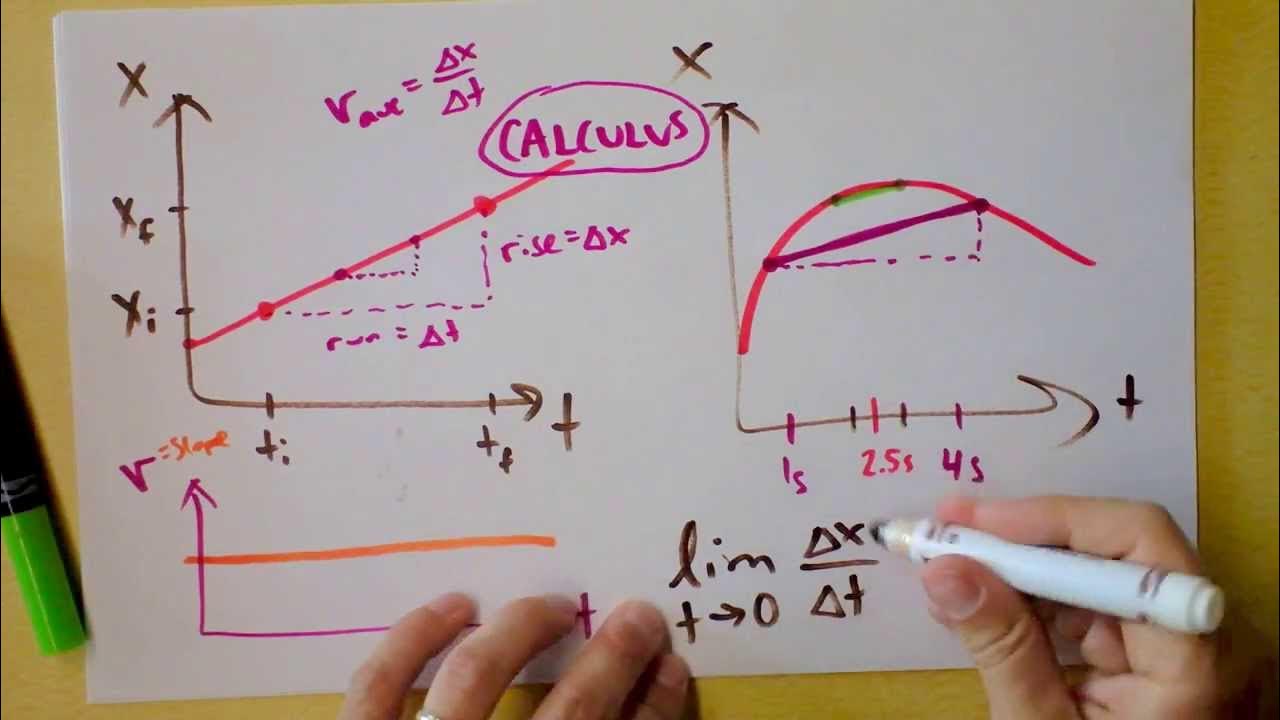Acceleration and Kinematic Equations | Physics in Motion
Summary
TLDRThis video segment explores the concept of acceleration, defining it as the rate of change of velocity over time, with a focus on its significance in physics. It explains the kinematic equations that describe motion under constant acceleration, highlighting how to calculate acceleration, displacement, and velocity. Through practical examples involving cars, viewers learn to apply these equations effectively, while graphical representations clarify the relationship between velocity and acceleration. By the end, the segment emphasizes the importance of understanding these fundamental principles for analyzing motion in real-world scenarios.
Takeaways
- 🚗 Acceleration is defined as the rate of change of velocity over time and is measured in meters per second squared (m/s²).
- 📏 The formula for calculating acceleration is: a = (v_f - v_i) / t, where v_f is final velocity, v_i is initial velocity, and t is time.
- ⚡ Acceleration can indicate speeding up or slowing down, depending on the signs of initial velocity and acceleration.
- 🔄 Changing direction also constitutes acceleration, even if the speed remains constant.
- 📚 Kinematics is the study of motion, encompassing displacement, velocity, acceleration, and time.
- 🧮 There are four main kinematic equations that relate these variables and can be used to solve motion problems.
- 🛑 To solve kinematic problems, first identify known variables and select the appropriate equation for the unknown.
- 📊 Velocity versus time graphs illustrate acceleration; the slope of the line represents the object's acceleration.
- ⏱️ Doubling the initial velocity while maintaining the same rate of deceleration significantly increases the stopping distance.
- 📈 A straight line on a velocity-time graph indicates constant acceleration, while a curve suggests changing acceleration.
Q & A
What is acceleration and how is it defined in physics?
-Acceleration is defined as the rate of change of velocity over time. It is measured in meters per second squared (m/s²) and is a vector quantity, meaning it has both magnitude and direction.
What is the formula for calculating acceleration?
-The formula for finding acceleration is: a = (v_f - v_i) / t, where 'a' is acceleration, 'v_f' is final velocity, 'v_i' is initial velocity, and 't' is the time taken.
How can you determine if an object is speeding up or slowing down?
-If the initial velocity and acceleration have the same sign, the object is speeding up. If they have opposite signs, the object is slowing down or decelerating.
What is kinematics?
-Kinematics is the science of describing the motion of an object. It involves studying displacement, velocity, acceleration, and time, typically using kinematic equations.
What are the four main kinematic equations?
-The four main kinematic equations are: 1) v_f = v_i + a * t, 2) displacement = 0.5 * (v_i + v_f) * t, 3) displacement = v_i * t + 0.5 * a * t², and 4) v_f² = v_i² + 2 * a * displacement.
How do you calculate the stopping distance of a car?
-To calculate the stopping distance, you can use the kinematic equations with known values of initial velocity, final velocity, and acceleration (which is negative during deceleration).
What happens to stopping distance when initial velocity is doubled?
-If the initial velocity of a car is doubled while keeping the rate of deceleration the same, the stopping distance increases significantly. For instance, doubling from 20 m/s to 40 m/s results in a stopping distance that is more than three times longer.
How can a velocity versus time graph represent acceleration?
-In a velocity versus time graph, the slope of the line represents the acceleration. A straight line indicates constant acceleration, while a changing slope indicates varying acceleration.
What does a negative slope on a velocity versus time graph indicate?
-A negative slope on a velocity versus time graph indicates that the object is decelerating, meaning its velocity is decreasing over time.
What is the significance of the initial and final velocities in kinematic equations?
-The initial and final velocities are crucial in kinematic equations as they determine the change in velocity, which is essential for calculating acceleration, displacement, and understanding the motion of the object.
Outlines

هذا القسم متوفر فقط للمشتركين. يرجى الترقية للوصول إلى هذه الميزة.
قم بالترقية الآنMindmap

هذا القسم متوفر فقط للمشتركين. يرجى الترقية للوصول إلى هذه الميزة.
قم بالترقية الآنKeywords

هذا القسم متوفر فقط للمشتركين. يرجى الترقية للوصول إلى هذه الميزة.
قم بالترقية الآنHighlights

هذا القسم متوفر فقط للمشتركين. يرجى الترقية للوصول إلى هذه الميزة.
قم بالترقية الآنTranscripts

هذا القسم متوفر فقط للمشتركين. يرجى الترقية للوصول إلى هذه الميزة.
قم بالترقية الآنتصفح المزيد من مقاطع الفيديو ذات الصلة

IGCSE Physics [Syllabus 1.2] Motion

Instantaneous Velocity, Acceleration, Jerk, Slopes, Graphs vs. Time | Doc Physics

Position/Velocity/Acceleration Part 1: Definitions

Acceleration | Motion | Physics class 9 | Khan Academy

Linear Motion - Distance, Displacement, Speed, Velocity, Acceleration - SPM & IGSCE Physics

Kinematics: Acceleration Vs Time Graph
5.0 / 5 (0 votes)
